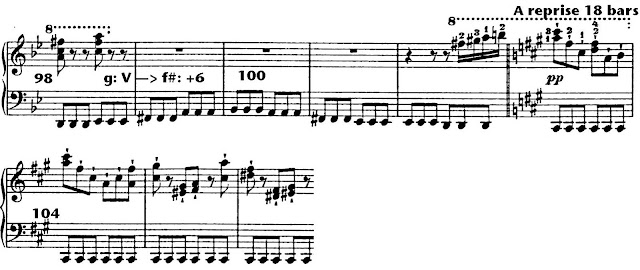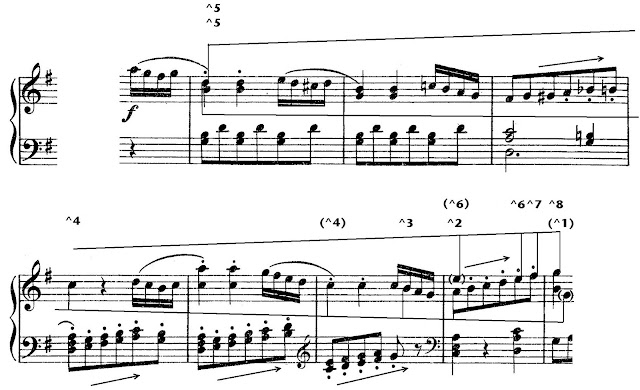Continuing with pieces listed in note 28 of my 1987
JMT article, we reach J. S. Bach, cantata No. 11, "Lobet Gott in seinen Reichen!", the soprano aria “Jesu, deine Gnadenblicke." For this piece I neglected to provide the qualifying comment that I gave for a Handel aria to be discussed in a later post; namely, that the rising line occurs in the instrumental parts, not in the voice, and thus—although interesting, to be sure—it is not part of the background. If this were 1990, I might be worried about the loss of an example of an ascending Urlinie, but since the number has burgeoned in the intervening years to well over 1500, it is now longer a matter of concern.
Cantata 11 is for the Feast of the Ascension, which fact probably sparked my interest in the first place, before I realized that the power of stylistic clichés in the 18th century would overwhelm text-painting/motivic analogues.
The text of the cantata follows the narrative of the Ascension. After a grand opening chorus of praise (complete with trumpets and drums), a bass recitative and alto aria implore Jesus not to leave his disciples. (The alto aria is unusually long.) A brief tenor recitative announces that He has ascended into Heaven, and a chorale verse follows, its opening line perhaps a bit too obvious—"Nun lieget alles unter dir"; literally "Now everything lies under you"—but the argument of the verse is actually "Everything is now subject to You," as the title of the chorale it derives from already makes clear: "Du Lebensfürst, Herr Jesu Christ" (You Prince of Life, Lord Jesus Christ). Further recitatives recount the explanation of the two angels who appear to the disciples and the latter's response. Then, as the tenth (and penultimate) number—another exuberant chorus closes the cantata as its n11—is the alto aria “Jesu, deine Gnadenblicke."
In the appendix of their book
Dance and the Music of J.S. Bach (1991), Meredith Little and Natalie Jenne label “Jesu, deine Gnadenblicke" a menuet, based on their extensive (and I will say quite convincing) research into dance topics. In early 18th century music and dance culture, the menuet combined qualities of the pastoral, elegance, and confirmation, and is therefore a perfect fit for this aria, in which the individual is reconciled to the Ascension, especially clear in the third line "Deine Liebe bleibt zurücke" (Your love remains behind).
The design is a da capo aria, laid out as follows (it fits the standard formula: two segments in A, each using the same two lines of text and surrounded by ritornellos; mode change for B with the remaining text, no ritornellos; and of course A da capo):
A
Ritornello
Jesu, deine Gnadenblicke
Kann ich doch beständig sehn. (close in the dominant)
Ritornello
Jesu, deine Gnadenblicke
Kann ich doch beständig sehn. (close in the topic)
Ritornello
B (opens in E minor, internal cadence in A minor, close in B minor)
Deine Liebe bleibt zurücke,
Daß ich mich hier in der Zeit
An der künft'gen Herrlichkeit
Schon voraus im Geist erquicke,
Wenn wir einst dort vor dir stehn.
A da capo
From the outset (and throughout, even under the voice part), the counterpoint in the instrumental parts is complex--far more so than the typical menuet of chamber or larger ensemble music.
The voice in the first section of A establishes a tonal space of B4-D5-G5 -- boxed below -- and lines move about within this space, but focused on the lower third. In this context, G5 is a cover tone and the principal space is B4-D5.
The second section in A is considerably more complex, and patterns of lines would be more abstract, but the clue to a principal space B4-D5 is in "kann ich doch" or just the word "doch." It may seem odd to give special attention to this word, as Bach certainly does, but it is the expressive key to the text. "Despite" (that's the sense of "doch" here) the Ascension and subsequent lack of His physical presence, I (the singer, the believer) can still continually see (beständig seh'n) Him in a vision of Grace (Gnadenblikke).

The closing ritornello continues the complicated counterpoint, which closes three times on the tonic: bar 6 of the example below, bar 10, and finally bar 17. The phrases are then six bars (1-6), four (7-10), four (10-13), and four (14-17). Of course, the overlapping at bar 10 would not happen in a menuet actually meant for dancing -- but, still, Bach holds to the underlying dance model surprisingly well. The first and last cadences ascend to ^8, the second, and weakest of the three, descends from ^3 (B5).





























